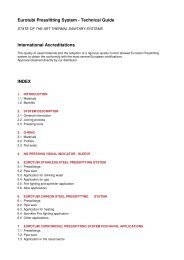Vis PDF - Damstahl
Vis PDF - Damstahl
Vis PDF - Damstahl
You also want an ePaper? Increase the reach of your titles
YUMPU automatically turns print PDFs into web optimized ePapers that Google loves.
Technical<br />
information<br />
Chapter 3: Applications of Common Stainless Steel Alloys<br />
Below, a number of common <strong>Damstahl</strong> stainless steels are listed together with their most common<br />
use. All types are listed according to the new EN standards, which almost (but not 100 %)<br />
correspond with the old W.Nr. system. The requirements of the AISI numbers are rarely identical<br />
with those of the parallel EN numbers, so instead, they should be regarded as the closest standard.<br />
Consequently, the translation should therefore be regarded as approximate, not absolute.<br />
Ferritic Stainless Steel:<br />
EN 1.4003 / AISI 410<br />
The simplest stainless steel, containing approx. 11 % Cr and the rest iron (Fe). Due to the absence<br />
of Mo and Ni, 4003 is a cheap alloy possessing a relatively poor corrosion resistance. Possesses<br />
a fine mechanical strength and may be forged as well as welded and can be used for a number of<br />
applications where mild carbon steel is inadequate, i.e. cars and buses, or where galvanized steel is<br />
used indoors. For improved weldability, the Ti stabilized parallel is EN 1.4512.<br />
EN 1.4016 / AISI 430<br />
16 % Cr steel possessing good mechanical strength and a superior corrosion resistance compared<br />
to the 4003. With regard to pitting corrosion above/below water, 4016 is close to but still slightly<br />
inferior to the austenitic 4301. 4016 possesses a good heat resistance and may be used up to 800<br />
ºC. However, welding is tricky, and a post-treatment is recommended in order to avoid brittle intermetallic<br />
phases along the welds. Widely used as sheets and coils for catering purposes. 4016 may,<br />
however, also replace galvanized steel for indoor purposes.<br />
EN 1.4113 / AISI 434<br />
Molybdenum containing (1 %), ferritic steel possessing a good corrosion resistance to chloride<br />
containing media; roughly in between the 4301 and 4401 classes. Due to the absence of stabilizing<br />
elements (Ti, Nb), the 4113 cannot be welded and should be used as coils or sheets.<br />
EN 1.4509 / AISI 441<br />
Ti-Nb stabilized, ferritic, 17½ % Cr steel, corresponding to a slightly upgraded 4016 (AISI 430), with<br />
improved properties. Due to its good corrosion resistance, weldability and relatively low and very<br />
stable price, 4509 is one of the most interesting and useful steels on the market and may be expected<br />
to replace 4301 in many major applications such as catering, building construction and heat<br />
exchangers. Theory as well as practice have shown 4509 to equal 4301 with regard to pitting corrosion<br />
(Chapter 4 + 5), and for hot parts, the ferrites are generally superior to the austenites due to<br />
their improved resistance towards SCC. Furthermore, 4509 has got a great potential as a substitute<br />
for galvanized steel. However, like all ferrites, it is only available as thin sheets or pipes. For all ferritic<br />
stainless steel types, care must be taken to ensure that the right welding process, filler metal<br />
and parameters are chosen.<br />
EN 1.4510 / AISI 439 (430Ti)<br />
With 15.5 % Cr, the 4510 corresponds to a Ti stabilized 4016 (no Nb). As 4509, the 4510 is weldable,<br />
but it is slightly less corrosion resistant than 4509 and harder to get. This combination is bound to<br />
make the 4510 a rare bird.<br />
287<br />
www.damstahl.com<br />
01.2013
















